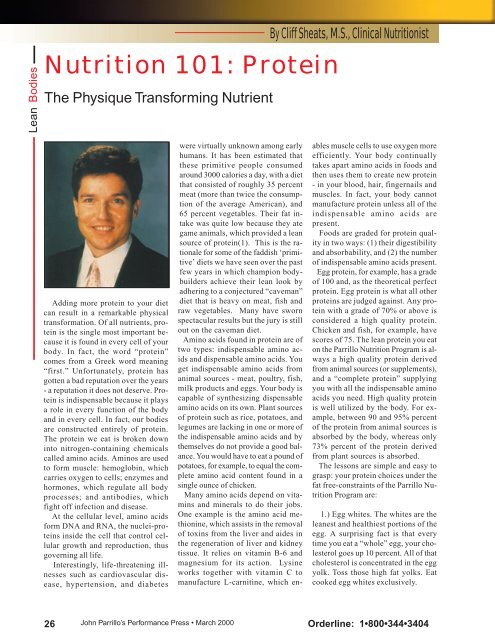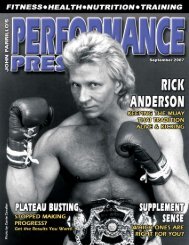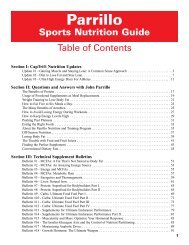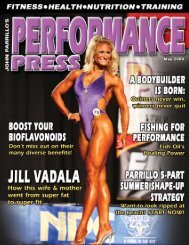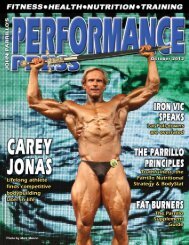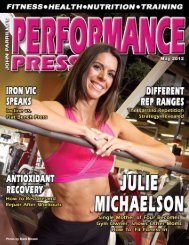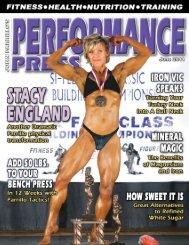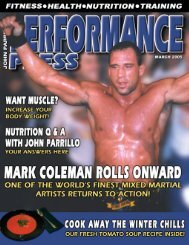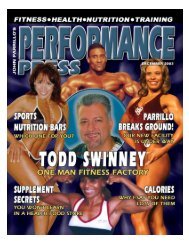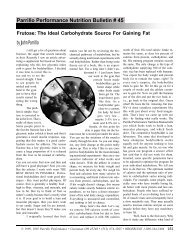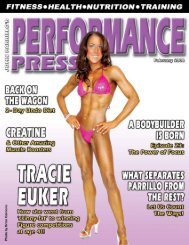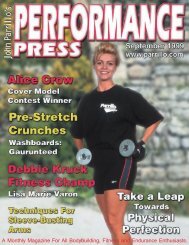A Monthly Magazine For All Bodybuilding, Fitness And - Parrillo ...
A Monthly Magazine For All Bodybuilding, Fitness And - Parrillo ...
A Monthly Magazine For All Bodybuilding, Fitness And - Parrillo ...
You also want an ePaper? Increase the reach of your titles
YUMPU automatically turns print PDFs into web optimized ePapers that Google loves.
Lean Bodies<br />
Nutrition 101: Protein<br />
The Physique Transforming Nutrient<br />
Adding more protein to your diet<br />
can result in a remarkable physical<br />
transformation. Of all nutrients, protein<br />
is the single most important because<br />
it is found in every cell of your<br />
body. In fact, the word “protein”<br />
comes from a Greek word meaning<br />
“first.” Unfortunately, protein has<br />
gotten a bad reputation over the years<br />
- a reputation it does not deserve. Protein<br />
is indispensable because it plays<br />
a role in every function of the body<br />
and in every cell. In fact, our bodies<br />
are constructed entirely of protein.<br />
The protein we eat is broken down<br />
into nitrogen-containing chemicals<br />
called amino acids. Aminos are used<br />
to form muscle: hemoglobin, which<br />
carries oxygen to cells; enzymes and<br />
hormones, which regulate all body<br />
processes; and antibodies, which<br />
fight off infection and disease.<br />
At the cellular level, amino acids<br />
form DNA and RNA, the nuclei-proteins<br />
inside the cell that control cellular<br />
growth and reproduction, thus<br />
governing all life.<br />
Interestingly, life-threatening illnesses<br />
such as cardiovascular disease,<br />
hypertension, and diabetes<br />
26<br />
were virtually unknown among early<br />
humans. It has been estimated that<br />
these primitive people consumed<br />
around 3000 calories a day, with a diet<br />
that consisted of roughly 35 percent<br />
meat (more than twice the consumption<br />
of the average American), and<br />
65 percent vegetables. Their fat intake<br />
was quite low because they ate<br />
game animals, which provided a lean<br />
source of protein(1). This is the rationale<br />
for some of the faddish ‘primitive’<br />
diets we have seen over the past<br />
few years in which champion bodybuilders<br />
achieve their lean look by<br />
adhering to a conjectured “caveman”<br />
diet that is heavy on meat, fish and<br />
raw vegetables. Many have sworn<br />
spectacular results but the jury is still<br />
out on the caveman diet.<br />
Amino acids found in protein are of<br />
two types: indispensable amino acids<br />
and dispensable amino acids. You<br />
get indispensable amino acids from<br />
animal sources - meat, poultry, fish,<br />
milk products and eggs. Your body is<br />
capable of synthesizing dispensable<br />
amino acids on its own. Plant sources<br />
of protein such as rice, potatoes, and<br />
legumes are lacking in one or more of<br />
the indispensable amino acids and by<br />
themselves do not provide a good balance.<br />
You would have to eat a pound of<br />
potatoes, for example, to equal the complete<br />
amino acid content found in a<br />
single ounce of chicken.<br />
Many amino acids depend on vitamins<br />
and minerals to do their jobs.<br />
One example is the amino acid methionine,<br />
which assists in the removal<br />
of toxins from the liver and aides in<br />
the regeneration of liver and kidney<br />
tissue. It relies on vitamin B-6 and<br />
magnesium for its action. Lysine<br />
works together with vitamin C to<br />
manufacture L-carnitine, which en-<br />
By Cliff Sheats, M.S., Clinical Nutritionist<br />
ables muscle cells to use oxygen more<br />
efficiently. Your body continually<br />
takes apart amino acids in foods and<br />
then uses them to create new protein<br />
- in your blood, hair, fingernails and<br />
muscles. In fact, your body cannot<br />
manufacture protein unless all of the<br />
indispensable amino acids are<br />
present.<br />
Foods are graded for protein quality<br />
in two ways: (1) their digestibility<br />
and absorbability, and (2) the number<br />
of indispensable amino acids present.<br />
Egg protein, for example, has a grade<br />
of 100 and, as the theoretical perfect<br />
protein. Egg protein is what all other<br />
proteins are judged against. Any protein<br />
with a grade of 70% or above is<br />
considered a high quality protein.<br />
Chicken and fish, for example, have<br />
scores of 75. The lean protein you eat<br />
on the <strong>Parrillo</strong> Nutrition Program is always<br />
a high quality protein derived<br />
from animal sources (or supplements),<br />
and a “complete protein” supplying<br />
you with all the indispensable amino<br />
acids you need. High quality protein<br />
is well utilized by the body. <strong>For</strong> example,<br />
between 90 and 95% percent<br />
of the protein from animal sources is<br />
absorbed by the body, whereas only<br />
73% percent of the protein derived<br />
from plant sources is absorbed.<br />
The lessons are simple and easy to<br />
grasp: your protein choices under the<br />
fat free-constraints of the <strong>Parrillo</strong> Nutrition<br />
Program are:<br />
1.) Egg whites. The whites are the<br />
leanest and healthiest portions of the<br />
egg. A surprising fact is that every<br />
time you eat a “whole” egg, your cholesterol<br />
goes up 10 percent. <strong>All</strong> of that<br />
cholesterol is concentrated in the egg<br />
yolk. Toss those high fat yolks. Eat<br />
cooked egg whites exclusively.<br />
John <strong>Parrillo</strong>’s Performance Press • March 2000 Orderline: 1•800•344•3404


